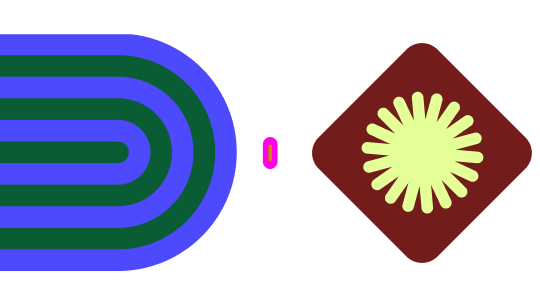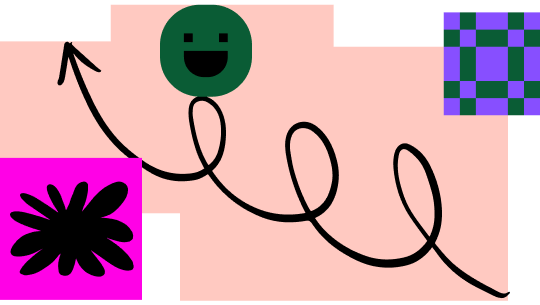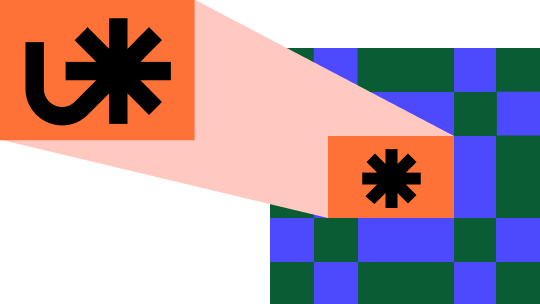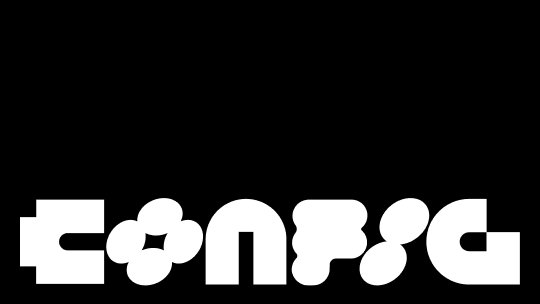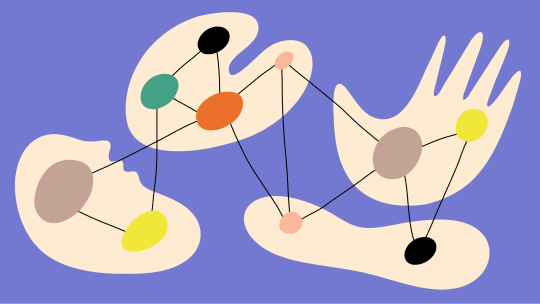How to create a persona in five steps
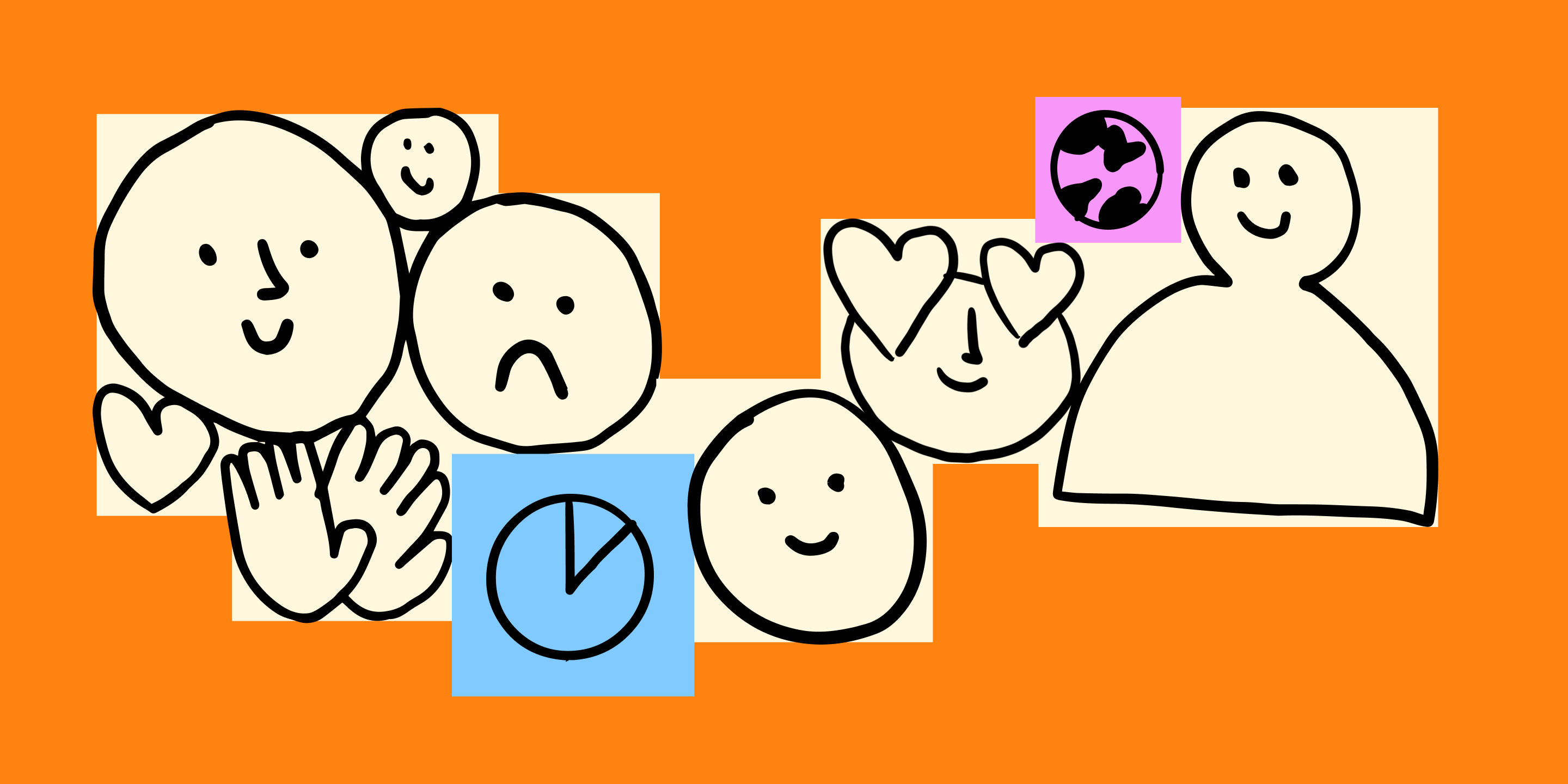
Who are you designing for? What does your target audience like? What are their motivations and frustrations? A persona can help you create better designs, products, and experiences to help your users meet their goals.
According to the HubSpot team, businesses and creators who offer a more personalized experience are 215% more likely to say their marketing strategies are effective, with 96% of marketers saying it increases the likelihood of buyers becoming repeat customers. Learn more about customer personas and walk step-by-step through the process.
Read on to learn:
- Why user personas matter
- How to create a persona with step-by-step instructions
- Different types of user personas, with examples
- Tips for navigating common user persona creation challenges
What is a user persona and why should you make one?
A user persona is a model of your target customer, created from real-world data and insights. It’s like a mini-biography that includes core details like demographics, goals, frustrations, and personality traits—painting a picture of someone who represents a larger group of your target users.
Think of it as answering the question: “Who is our ideal customer?” Knowing the answer to this question helps your team make informed decisions, whether it’s refining your marketing strategy or guiding your product development roadmaps.
Let’s say your website helps people find coupons and rebates for national stores. One of your personas may be “Promo-Code Pat,” a 38-year-old bargain hunter who loves cross-shopping for the best deal. Pat is tech-savvy, clever with search terms, and loves social media and word games.
By understanding Pat’s goals and behaviors, your team can design with them in mind, making sure your site speaks to their needs and keeps them coming back.
How to create a persona in five steps
Creating a great persona starts with empathy—seeing the world through your user’s eyes. By understanding their needs, you can design experiences that resonate. The level of detail in your persona will depend on your business goals and the data your team finds beneficial to collect.
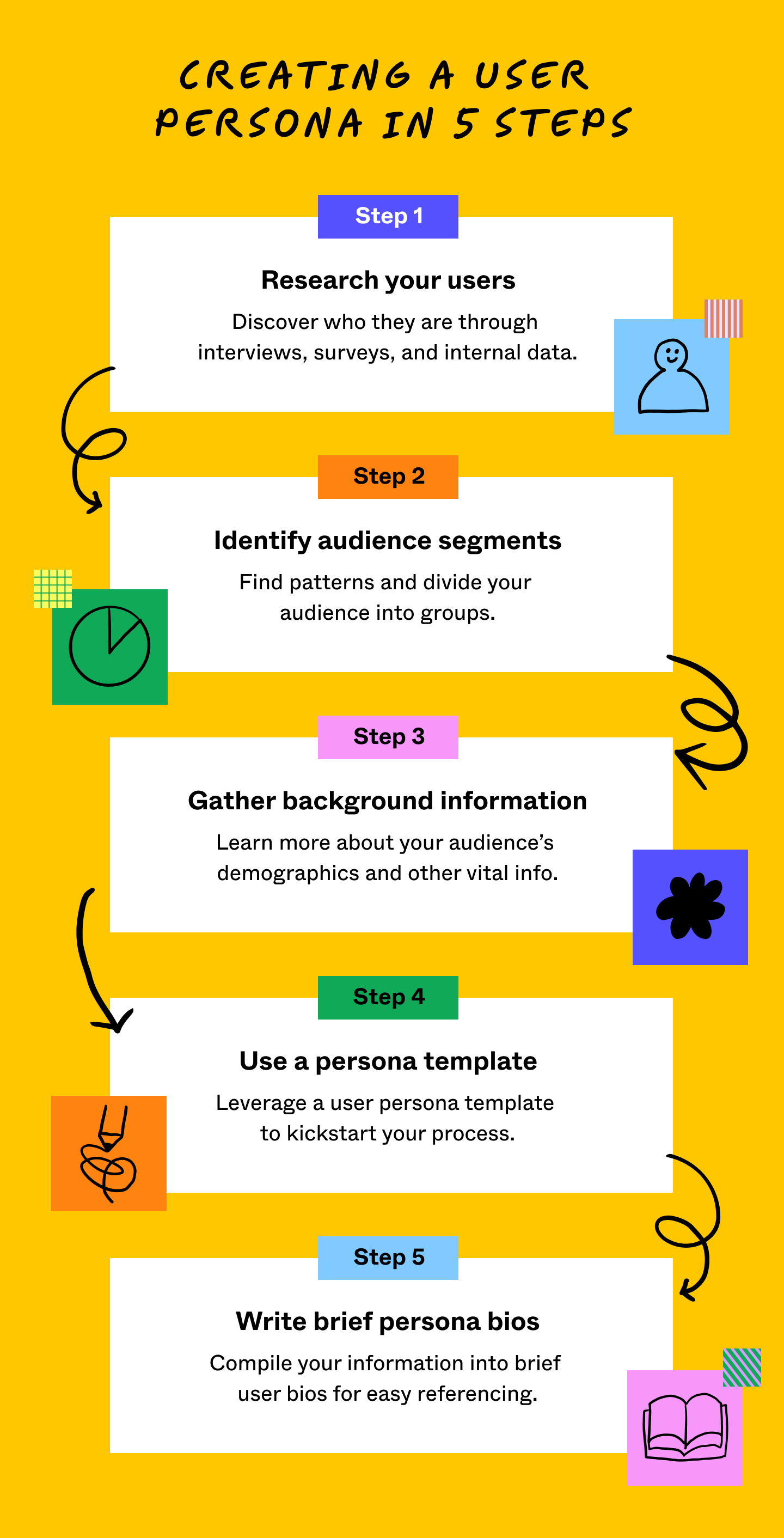
Step 1: Research your users
Strong personas are based on reliable data from a variety of sources, not hunches or assumptions. Here’s how to gather the insights you need:
How to research existing users
If you have existing users, you’ve already got valuable data to inform your personas. Here's how to tap into it:
- Interview users. Use focus groups, online surveys, or schedule one-on-one conversations to ask your users what they like about your brand and why they use your product or service. Aim to speak with at least 10–20 people to spot trends and gain deeper insights into their backgrounds, personalities, and interests.
- Run a survey. If you’re working with a broad user base, run an online survey. Offer incentives like discounts or store credit to encourage honest feedback.
- Talk to your sales and support teams. Your customer-facing teams hear it all—the frustrations, pain points, and the wins. They can provide real-world insights into your audience’s needs and traits.
- Review online analytics. Tools like Google Analytics help you understand the demographics and behavior of your site visitors. Track their customer journey across devices.
- Let email subscribers self-segment. Forbes recommends letting users select their interests and indicate their preferences when completing your marketing permission signup form.
How to apply market research
If you’re launching your first digital product and don't have users yet, market research can inform your personas. Here’s how to gather reliable data:
- A/B testing. See which options your target audience prefers by testing multiple options at once.
- Focus groups. Organize discussions with potential users to gather detailed data about their preferences.
- Interviews. Dive deep with interviews to discover motivations, pain points, and goals.
- Surveys. Cast a wider net with online or physical surveys to gather more insights.
- Web scraping. Analyze information from relevant websites to discover patterns and potential audience behavior.
Step 2: Identify audience segments
Once you’ve gathered your initial research, it’s time to spot patterns. The goal is to group users with similar characteristics into a few distinct categories. For example, if you’re working on a meditation app, your audience might break down like this:
- High-performing professionals
- Holistic health enthusiasts
- Stay-at-home parents
While all these users love your product, their needs and habits might be totally different. These differentiated groups give you the basis for three distinct personas, each reflecting a different type of user.
To make sense of large amounts of data, use brainstorming templates or mind maps. FigJam templates help you organize and label trends, leave notes, and host online meetings to share insights and inspiration.
Step 3: Gather background on your personas
Your research will uncover key details about each persona, giving you a clearer sense of who this person is and why they’re drawn to your product. With just a few data points, you can start shaping their story.
For example, let's take “High-Performance Jamie,” a power user of your meditation app. Here’s what Jamie's persona might look like:
- Demographic: 42 years old, married with two kids, affluent ZIP code
- Education: Master’s degree
- Professional background: 3 years as a C-suite executive experience
- Average income: $125,000 per year
- Personality traits: Driven, focused, analytical
- Behavioral attributes: Wakes up early and uses LinkedIn
- Pain points: High stress levels at work
- Frustrations: Dislikes inefficiency, unhealthy habits, and working late
- Motivations: High performer who views meditation as essential
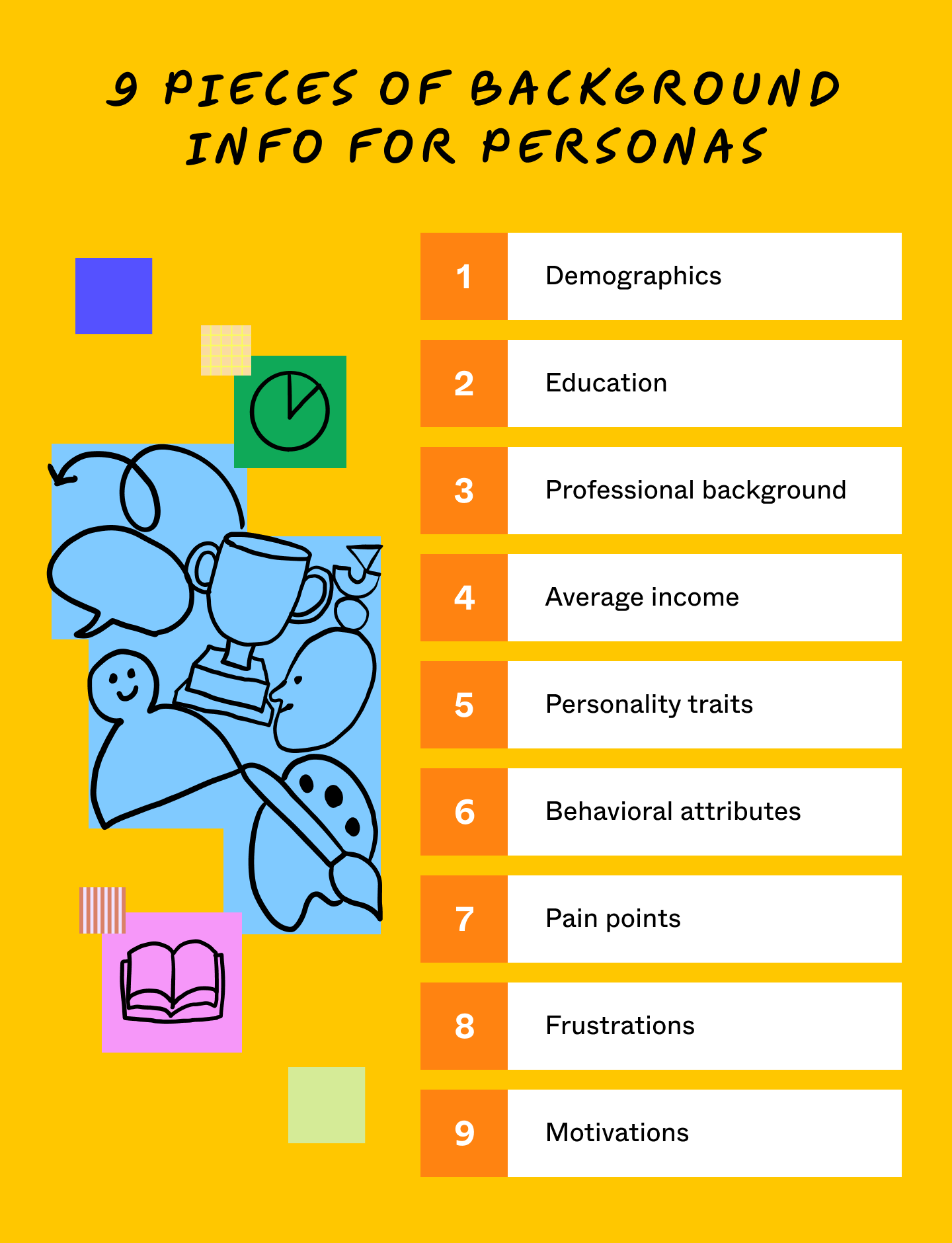
Step 4: Start filling in a persona template
Use FigJam’s persona template to gather key data, traits, and user info to share with stakeholders. To expand your persona with more visuals, try creating a mood board. This helps stakeholders quickly understand who your users are, how to engage them, and how to design experiences that meet and exceed their expectations.
Step 5: Write a brief bio for your personas
A short bio can make your personas feel more relatable, helping your team empathize with users and anticipate their needs and behaviors.
Here’s an example based on High-Performance Jamie:
Jaime works at home but is always on the go. Some days, Jamie's only downtime is while driving to appointments, schools, and stores. That's when Jamie listens to health and wellness podcasts. To manage stress at work and to reset before family time, Jamie meditates using an app.
Jamie stays active with Pilates, shops at Trader Joe’s, streams her favorite shows on Hulu, and comments on friends' Instagram posts. Jamie is most likely to download apps promoted on Instagram, Hulu, or on health and wellness podcasts.
Once your personas take shape, invite your team to add detail to the FigJam persona template. As your team gets to know your personas, they’ll be better equipped to design workflows and make informed decisions that align with your users’ needs.
User persona examples
Different types of user personas can help you match your audience’s needs more effectively. By building a persona that accurately reflects your users, your team can make more informed decisions. Remember to update your personas regularly to keep them aligned with your audience's evolving needs.
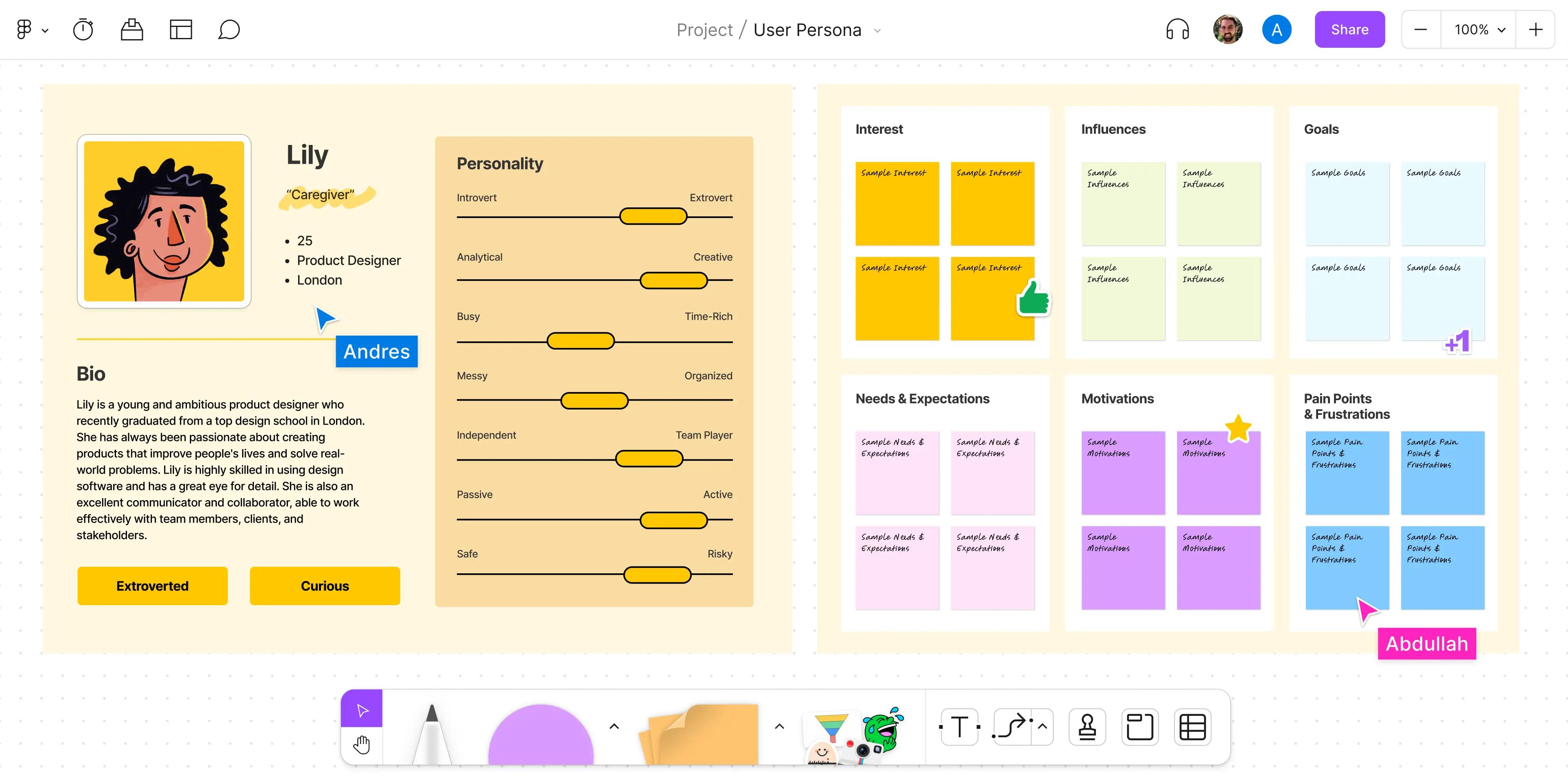
Goal-directed personas
A goal-directed persona is ideal when you're focusing on your user’s main intent. These personas highlight what users are trying to achieve and the obstacles they face along the way.
Example: For a student persona, their goal might be finding a solution that offers immediate savings. Meanwhile, a business professional’s goal could be a solution that saves them money over time.
Role-based personas
Role-based personas focus on a user's role or position. The targeted individual could be a small business owner or the head of marketing for a large corporation. These personas emphasize the responsibilities, decision-making power, and tasks related to their position.
Example: A marketing executive persona might highlight decision-making power and budget access, while a sales manager persona could emphasize relationship-building for long-term success.
Engaging personas
An engaging persona brings your audience to life by including more personal details like backstories, personality traits, and individual motivations. While fictional, these personas help your team connect with the audience on a deeper level, offering clarity when making user-centric decisions.
Example: Your persona, Molly, is a 22-year-old college student. Her motivations drive her to purchase decisions focused on more affordable, future-forward solutions.
Common persona challenges and how to overcome them
Creating user personas can be challenging, but with the right strategies, you can overcome the most common obstacles. Whether it’s getting your team on the same page or keeping your personas current, here are some helpful tips to tackle the challenges:
- Align your team on personas. Host collaborative workshops to gather everyone’s viewpoints and align on your persona strategy.
- Avoid customer stereotyping. Make decisions based on data, not guesswork, and encourage empathy exercises with your team.
- Decide how many personas to create. Identify user segments and base the number of personas on solid data..
- Pinpoint your target audience. Conduct user research and interviews to refine your understanding of your audience.
- Keep personas fresh and updated. Update your persona regularly to reflect shifts in user behavior, goals, and motivations.
- Collect ample data. Use different data collection methods, including surveys, focus groups, and interviews.
- Manage resource or budget constraints. Prioritize the most critical personas that best align with your business's key objectives.
Make your next persona with FigJam
Transforming data into user personas is key to creating designs that resonate, and FigJam makes creating, sharing, and editing personas more manageable. With FigJam AI tools and persona templates, you can seamlessly brainstorm, collaborate, and refine your personas as a team. Here's how to get started:
- Use the FigJam persona template to zero in on your target audience.
- Create an empathy map to better understand your users.
- Map out where your users are in their customer journey.
Are you ready to create user personas that help guide your team toward success?
Create your persona with FigJam.
Keep reading
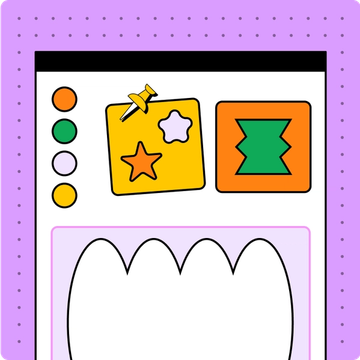
What is a mood board
Where does inspiration come from? For designers, the answer is usually a mood board.
Learn more
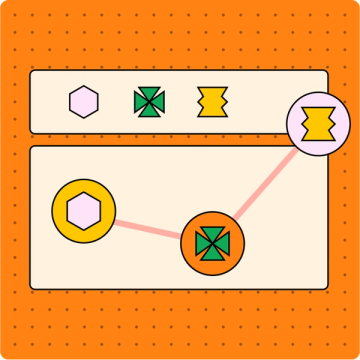
How to make a customer journey map
Learn how customer journey maps can help you sharpen design and marketing efforts, turning casual visitors into passionate brand advocates.
Learn more
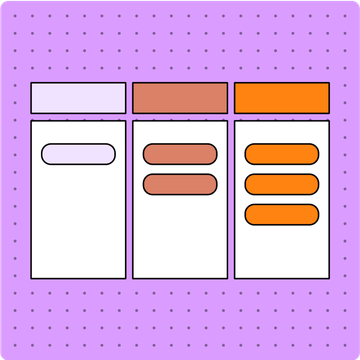
How to create a product development roadmap
Get your next product effort off to a running start with a product development plan that clearly maps out your goals, priorities, and timelines.
Learn more
